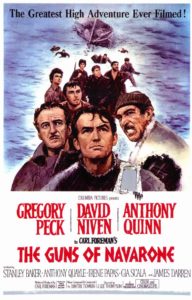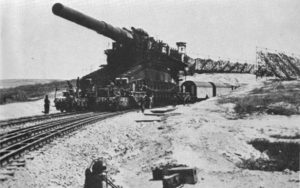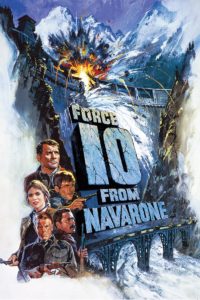The Navarone Films – One, a Classic. Its Follow-up Mediocre
All clickable links in red
Alistair MacLean was an exceptionally successful writer who crafted a series of adventure-war-spy stories. His experience as a sailor in the “Arctic Convoys” resulted in his first – and probably his best – book, HMS Ulysses (1955). After that, there was no looking back, as many of his 1960s books were made into films of varying quality. But nothing approached the sheer grandeur and storytelling of The Guns of Navarone (1957), which was made into one of the most successful war movies of the early 1960s. Its follow-up Force 10 from Navarone (1968) was filmed in the mid-1970s with mediocre results. However, the original film stands up even today, and in retrospect, so does the follow-up. MacLean’s book-to-screen list is impressive and includes the following books made into films
- The Last Frontier aka The Secret Ways (1959) – made into a 1961 film ; available for free on YouTube
- Ice Station Zebra (1960) – made into a successful 1968 film that was nominated for a Special Effects Oscar.
- Fear is the Key (1961) – made into a 1972 film and copied in various Bollywood movies, most notably in Chuppa Rustom (1973)
- The Golden Rendezvous (1962) – a 1977 release and a box office flop; available for free on YouTube.
- When Eight Bells Toll (1966) – a 1971 release with an unbelievably young Anthony Hopkins as a secret agent; available for free on YouTube
- Where Eagles Dare (1967) – a wildly popular and highly successful 1968 release with “are you kidding me” type of body count. Still popular across the world
- Puppet on a Chain (1969) – a 1970 release with a superb chase through Amsterdam’s canals. Free on YouTube
- Caravan to Vaccares (1970) – a mediocre 1974 release ; free on YouTube
- Bear Island (1971) – even big stars couldnt save this mediocre 1979 release; free on YouTube
- The Way to Dusty Death (1973) – made into a 1995 TV movie
- Breakheart Pass (1974) – Fairly good 1975 action thriller
After his death, his “brand name” was used successfully by many “successors” who wrote books of mediocre quality – much like later “books” by Robert Ludlum (The Bourne franchise), Tom Clancy (Jack Ryan, The Power Play and Op Centre franchises), and many other writers, just to cash in on the name.
However, MacLean has emerged as the favourite of many modern writers who cut their “milk teeth” reading his well-plotted yarns of the 1960s.
The Guns of Navarone (1961) – A CLASSIC
Director: J. Lee Thomson.
Cast: Gregory Peck. David Niven. Anthony Quinn. Anthony Quayle. Stanley Baker. Irene Papas. James Darren.
Platforms – Amazon Prime (on rent). YouTube (free)
Duration: 2 hours 55 minutes
British soldiers are trapped on the island of Leros in the Mediterranean Sea. Any effort to rescue them by sea is impossible as the approaches to the island are guarded by two powerful radar-directed guns that can sink any ship.  Air attacks are impossible as the guns are set into the side of a sheer cliff that falls to the sea. The desperate Allies devise a solution – a commando raid from an unknown approach. The team consists of a Mountaineer, Mallory (Gregory Peck), a demolitions expert, Miller (David Niven), a Cretan resistance man, Andrea (Anthony Quinn), a wireless and medical expert, Brown (Stanley Baker), a cold-blooded killer Pappadimos (James Darren) led by regular Army Major Roy Franklin (Anthony Quayle). In civilian clothes and posing as fishermen, their “fishing” boat is intercepted by a German motorboat, which is sunk by the team. They approach the island in the middle of a storm and reach a safe beach, scaling the cliff, only to see Franklin break his legs and become a casualty. With orders to contact the local resistance, they reach the ruins of an ancient temple. Their Greek Resistance contact, Maria (Irene Papas), has an assistant, Maria (Gia Scala), who has been supposedly tortured, turning her dumb with shock. As the group make their way through mountains and villages, the Germans always seem to be one step ahead. The Guns must be destroyed in four days as the naval ships would come to Leros to evacuate the trapped soldiers, irrespective of whether The Guns have been destroyed.
Air attacks are impossible as the guns are set into the side of a sheer cliff that falls to the sea. The desperate Allies devise a solution – a commando raid from an unknown approach. The team consists of a Mountaineer, Mallory (Gregory Peck), a demolitions expert, Miller (David Niven), a Cretan resistance man, Andrea (Anthony Quinn), a wireless and medical expert, Brown (Stanley Baker), a cold-blooded killer Pappadimos (James Darren) led by regular Army Major Roy Franklin (Anthony Quayle). In civilian clothes and posing as fishermen, their “fishing” boat is intercepted by a German motorboat, which is sunk by the team. They approach the island in the middle of a storm and reach a safe beach, scaling the cliff, only to see Franklin break his legs and become a casualty. With orders to contact the local resistance, they reach the ruins of an ancient temple. Their Greek Resistance contact, Maria (Irene Papas), has an assistant, Maria (Gia Scala), who has been supposedly tortured, turning her dumb with shock. As the group make their way through mountains and villages, the Germans always seem to be one step ahead. The Guns must be destroyed in four days as the naval ships would come to Leros to evacuate the trapped soldiers, irrespective of whether The Guns have been destroyed.
The film is an adventure story. A spy story. A war movie. A commando raid story. And much more. It is truly a multi-dimensional story that never lets up, thanks to some terrific writing from Carl Foreman, who was then coming back from the infamous Hollywood (“ban all Commies”) blacklist. As the raid progresses, we are unsure how the team will succeed. After all, Navarone is an island, and it’s easy for any search party to scan all areas.
Some of the scenes are based on real stories. Since the Allies were on the defensive, the easiest and cheapest way to hurt the Germans was to carry out many Commando raids on over-extended German garrisons across the various tiny islands. The “burning of Mandrakos” is similar to the burning of many Cretan villages after the kidnapping of General Heinrich Kreipe (which became the movie Ill Met by Moonlight).
Last but the least. The Germans were OBSESSED with Gigantic Guns. The bigger, the better, seemed to be their  philosophy. However, these massive guns had their travelling circus in terms of support staff, had a poor rate of fire, were subject to severe barrel wear and tear, and were simply vulnerable to Allied Airpower. Most of them had minimal success. These included the 15 and 17 cm Kanone Eisenbahn, 21 cm Kanone12 Eisenbahn, 28 cm Kanone 5 Eisenbahn, 28 cm Bruno Kanone Eisenbahn, and 80 cm Gustav Kanone Eisenbahn – the Eisenbahn meant that all of them were rail-mounted. The 80 cm required two sets of parallel tracks to travel – see the above photo with the human on the left, to give a perspective/scale – and was crewed by almost a thousand men.
philosophy. However, these massive guns had their travelling circus in terms of support staff, had a poor rate of fire, were subject to severe barrel wear and tear, and were simply vulnerable to Allied Airpower. Most of them had minimal success. These included the 15 and 17 cm Kanone Eisenbahn, 21 cm Kanone12 Eisenbahn, 28 cm Kanone 5 Eisenbahn, 28 cm Bruno Kanone Eisenbahn, and 80 cm Gustav Kanone Eisenbahn – the Eisenbahn meant that all of them were rail-mounted. The 80 cm required two sets of parallel tracks to travel – see the above photo with the human on the left, to give a perspective/scale – and was crewed by almost a thousand men.
The film was shot entirely in Rhodes Island, Greece and benefited from the cooperation of the Greek Armed Forces, whose heavy equipment like tanks, ships, planes, etc, are used as “German equipment”.
For a film of its time, there is a surprising amount of anti-war sentiment, voiced mainly through Miller, who hates “bloody officers” and “responsibility”. The working soldier’s disdain for officers is expressed in the initial scene when an Australian Squadron leader (future star Richard Harris) who has lost half his squadron shouts at “dropping the bloody joker who dreamt up this bloody operation on bloody Navarone without the benefit of a bloody parachute”. Yes – this was 1961, and the language would obviously change in another ten years when the F word would become common, but here it is “bloody clean”.
For an action spectacular, performances hardly matter. Still, Gregory Peck is superb as the soft-spoken but tough Mallory. In the book, Mallory and Miller are friends from the start, but here, they start as antagonists and ultimately become working friends, respecting each other. Quinn is superb as the rough and tough Andrea, who has sworn to kill Mallory but finally relents; again, this is unlike the book where Andrea and Mallory are friends. Anyway, the creative writing works here, causing some “internal tension” in the team, which has to focus on the common goal of destroying The Guns.
Despite its “age”, the film remains a multi-dimensional classic action adventure war story. It’s free on YouTube
Script – 5 out of 5
Story – 4 out of 5
Direction – 5 out of 5
Photography – 4 out of 5
Total – 4.5 out of 5
Force 10 from Navarone (1978) – Deserves Better
Director: Guy Hamilton
Cast: Robert Shaw. Edward Fox. Harrison Ford. Franco Nero. Barbara Bach. Carl Weathers. Richard Kiel.
Platforms – You Tube (free)
Duration: 2 hours
The book was written to capitalise on the success of the film version. So Mallory, Miller and Andrea parachuted into war-torn Yugoslavia, resulting in its own set of problems. The film version dispensed altogether with Andrea.
So you have Mallory (Robert Shaw), Miller (Edward Fox) and an American team led by Colonel Barnsby  (Harrison Ford) parachuting into Yugoslavia with a black stowaway, Sergeant Weaver (Carl Weathers). They are greeted by what seem to be Communist Partisans led by Maritza (Barbara Bach) and a giant soldier, Captain Drazak (Richard Kiel). They turn out to be Chetniks who support the Germans. Mallory and the team are to be executed when Maritza kills the Chetnik escort and reveals herself to be a Communist Spy. Mallory “hits” Maritza, and they “escape” to join the Communist Partisans. Their target? a Dam upstream of a major bridge, the river being the boundary between the German and Partisan-held territories.
(Harrison Ford) parachuting into Yugoslavia with a black stowaway, Sergeant Weaver (Carl Weathers). They are greeted by what seem to be Communist Partisans led by Maritza (Barbara Bach) and a giant soldier, Captain Drazak (Richard Kiel). They turn out to be Chetniks who support the Germans. Mallory and the team are to be executed when Maritza kills the Chetnik escort and reveals herself to be a Communist Spy. Mallory “hits” Maritza, and they “escape” to join the Communist Partisans. Their target? a Dam upstream of a major bridge, the river being the boundary between the German and Partisan-held territories.
I saw the film on its initial release and was utterly disappointed with its limp story. However, a recent viewing brought an entirely different view that it is not as bad as it is made out to be, based on the harsh reality of Yugoslav WW2 Politics. In simple terms, there were :
- The Royalists, aka Chetniks, wanted Yugoslavia’s King to return. Initially, they resisted the Germans but ended up collaborating with them because both the Royalists and the Germans were opposed to …
- The Communists – aka The Partisans. They were, by and large, successful in keeping the Germans on their toes, and as a result, the Allies gave them material and logistical support.
- There were also various ethnic tensions – Croat, Bosnian, Serbian etc . The Croats and Bosnians (Muslims) , mostly collaborated with the Germans. Funnily, Tito, the Partisan Leader was half Croat!
The film builds on this complex rivalry where the Communist spy vs Chetnik/Royalist spy tries to wreck each others’ team while the Allied team proceeds to do the job. The ending is quite “filmi” but with a touch of British humour – “We may have done the job, but this area will be swarming with a lot of angry Germans”.
Performances are adequate but Edward Fox stands out as Miller, the explosives expert. Guy Hamilton seems to be in a “let’s get it over with” mood, given that he had helmed the Bond movies and war movies (Battle of Britain, etc.), though there are some deft moments – such as the discovery of the German spy ( we can easily predict who it is). The film was shot entirely in Yugoslavia, with the team benefiting from the Yugoslav Army and its “German equipment”.
Trivia: Many World War 2 movies were shot in Yugoslavia as they still had World War 2 vintage equipment, and the Yugoslav Army was free to act as extras – as long as they were paid their daily wages. Undoubtedly, all the foreign money was added to the Government coffers. For more, those interested can read this article Cinema Komunisto https://www.theguardian.com/film/2012/nov/16/cinema-komunisto-yugoslavian-film
The film is free on YouTube
Script – 3 out of 5
Story – 4 out of 5
Direction – 3 out of 5
Photography – 4 out of 5
Total – 3.5 out of 5
Great writing as usual!